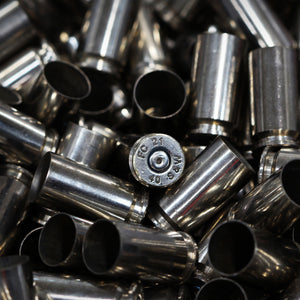As I write this, the great handgun caliber war wages on. The various factions of concealed carriers, LEOs, and 2A supporters are dug in and defending their territory, seemingly for decades now. I’ve largely stayed out of it, preferring to take in the action from afar. Do I dare stray into the fray?
Since I’m not the bravest of lads, I’m going to mostly stay on the sidelines, my knowledge base on the subject being best described as very deep, but not wide. I know three calibers of Federal HST self defense rounds better than possibly anyone on the planet. I’ve shot hundreds of thousands of HSTs in 9mm, .40 S&W, and .45 ACP. I don’t consider that expertise to be really that useful in the broad world of self defense, but I do have some opinions that I feel can add to the discussion. One of those opinions is that .40 S&W has been played dirty. It’s the FBI’s little wunderkind that gets harassed on the playground. But it’s a very capable round, trust me.
At Bullet Bouquets, we keep a shooting log, monitoring the yields of each batch of fired rounds. We keep as much data on the process as we reasonably can, in our efforts to increase yields and monitor the health and safety of our shooting equipment. It’s led to two very notable conclusion: 1) that the .40 wears out barrels far faster than the other two calibers, and 2) the .40 causes nearly all of our equipment failures.
 Check out our premium once-fired brass, in 9mm, .40 S&W, and .45 ACP!
Check out our premium once-fired brass, in 9mm, .40 S&W, and .45 ACP!
1) We routinely get exceptional life out of our 9mm and .45 cal barrels. By exceptional, I mean 20k+ rounds. It’s a rare day in the shop when we have to retire one of those barrels. But the .40, on the other hand... Sometimes it feels like we’ll replace a barrel after only a week worth of service. Usually we get about 10k rounds through them before they start misbehaving, causing inconsistent expansions.
2) There are the nasty little milestones in our seven-year-old shooting log indicating broken parts. Almost without exception, every time our shooting system has broken, it’s been while we’re shooting .40 S&W. Simple failures, like a weather checked hose giving up the ghost, to a PVC plug rapidly leaving the vicinity of the tank, to the spectacular failure of an entirely shattered tank. Each time, .40 cal has presided over the failure. And while there’s definitely a chance that this is just coincidence, at a certain point data starts forming an unmistakable trendline.
So why is .40 so tough on barrels and equipment? First off, the maximum chamber pressures are slightly higher in .40 S&W (35,000 psi), vs. 9mm (34,000 psi), or .45 ACP (21,000 psi). For sure, Federal is probably not loading their HSTs right up to the maximum, but it is a possibility that they’re loading the .40 a little hotter than the 9mm or .45 ACP. Secondly, given the bullet weights of 124, 180, and 230 grains, muzzle energies are significantly higher in .40 S&W (about 410 ft-lbs) than in 9mm or .45 ACP (both around 355 ft-lbs). Newton's laws are a constant reminder that increased bullet energy means increased energy is absorbed by all parts of the system, including the brass, gun, barrel, and tank.
So what’s the takeaway here? Should you trust .40 S&W to defend your life because it chews through barrels? Because it’s been shown to break Bullet Bouquets’ parts? That sure would be a silly reason in my opinion. But does our data prove that .40 packs a greater wallop than 9mm or .45? I think it does.
And here comes the classic disclaimer: If you train sufficiently with your .40, and can quickly and accurately get shots on target, and you don’t mind the smaller magazine capacity, then do it! Carry that .40 S&W. I have no doubt that if you do your job, the .40 will be slightly better at stopping threats than the 9mm and .45, all other things being equal. Just be warned that you’re going to be fighting a special uphill battle in the great handgun caliber war.
Happy shooting!

